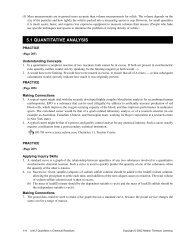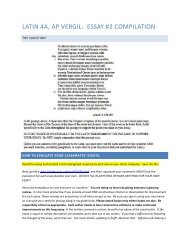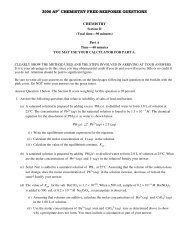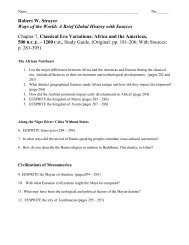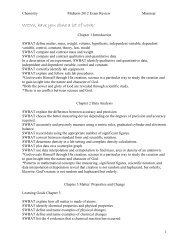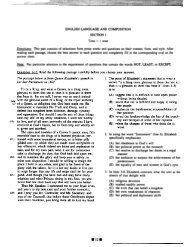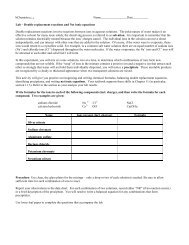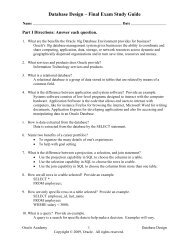Chapter 17 Study Guide - Quia
Chapter 17 Study Guide - Quia
Chapter 17 Study Guide - Quia
Create successful ePaper yourself
Turn your PDF publications into a flip-book with our unique Google optimized e-Paper software.
________1. The chief beneficiaries of all but one of the Atlantic revolutions were<br />
(A) propertied white men of the “middling classes.”<br />
(B) upper class, aristocratic women.<br />
(C) lower class white men who did not own property.<br />
(D) slaves and indentured servants.<br />
________2. A distinguishing characteristic of the French Revolution when compared to the<br />
American Revolution was that the French Revolution<br />
(A) drew on Enlightenment ideas about liberty.<br />
(B) sought to recreate society from scratch.<br />
(C) sought to preserve existing liberties rather than to establish new ones.<br />
(D) maintained the monarchy, whereas the Americans broke with this form of government.<br />
________3. Which of the following was an outcome of the American Revolution?<br />
(A) Political authority no longer resided in the hands of pre-Revolutionary colonial elites.<br />
(B) Enlightenment ideals were increasingly rejected as part of a quest for stability.<br />
(C) It established nearly universal voting rights in the former colonies.<br />
(D) It accelerated the established democratic tendencies of the colonial societies.<br />
________4. What was the most distinctive feature of the Haitian Revolution?<br />
(A) Its status as the only completely successful slave revolt in world history.<br />
(B) The success of different races at putting aside differences in the name of the revolution.<br />
(C) Its failure to influence the populations of other Caribbean islands.<br />
(D) Its relative lack of violence.<br />
________5. What best describes the result of Napoleon’s conquest and reform of European lands<br />
outside France?<br />
(A) The conquered were grateful to Napoleon.<br />
(B) The conquered accepted many of the reforms, but revolted against French control.<br />
(C) The conquered refused to accept the reforms and fought bitterly against French control.<br />
(D) The conquered refused to accept the reforms, but passively accepted French control.<br />
________6. Which of the following was an impact of the Haitian Revolution throughout the Atlantic<br />
world?<br />
(A) Napoleon bought the Louisiana territory from the United States.<br />
(B) The movement to abolish slavery collapsed as fear of free slaves grew.<br />
(C) Slave owners and whites were filled with fear and trepidation.<br />
(D) Similar slave insurrections spread throughout the Atlantic world, including Brazil,<br />
Jamaica, and Louisiana.<br />
________7. Which of the following is one reason why the Spanish American revolutions took longer<br />
and were more difficult than the (North) American Revolution?<br />
(A) Language barriers in Spanish America<br />
(B) Greater wealth in Spain than in Britain<br />
(C) Divisions of class, race, and region within Spanish America<br />
(D) Stability of the royal government in Spain<br />
________8. What great fear drove the Latin American creole elites to pursue independence and<br />
political change?<br />
(A) They feared falling behind the United States economically and politically.<br />
(B) They feared that the Church was gaining too much power over them.<br />
(C) They feared that social unrest from the lower classes and nonwhites would get out of<br />
control.<br />
(D) They feared the Spanish and Portuguese monarchies were going to replace them with<br />
new elites drawn from the lower classes.<br />
________9. Which of the following arguments made the cause of abolition widely acceptable in the<br />
nineteenth century?<br />
(A) Slavery was immoral.<br />
(B) Slavery was not condoned in the Bible.<br />
(C) Slavery benefited Portuguese slave traders too much.<br />
(D) Slavery was no longer necessary for economic progress.<br />
________10. Which of the following is true of the women’s movement by the early 1900s?<br />
(A) It had secured widespread voting rights for women across Europe.<br />
(B) In the most industrialized countries of the West, it had become a mass movement.<br />
(C)<br />
(D)<br />
Large numbers of working-class women had gained entrance to universities.<br />
While a number of nations had strong feminist movements, there was little or no contact<br />
between them.




